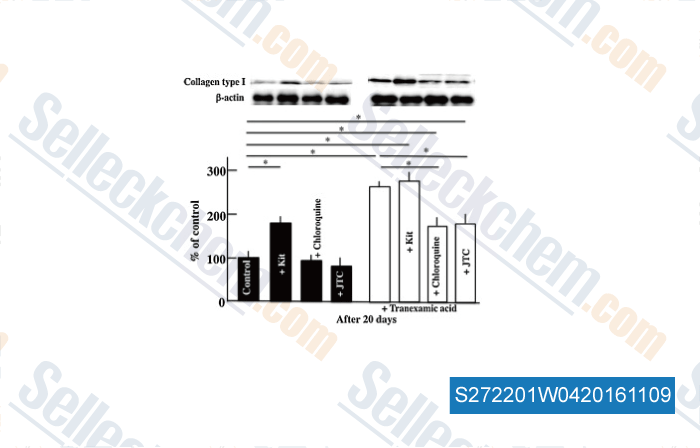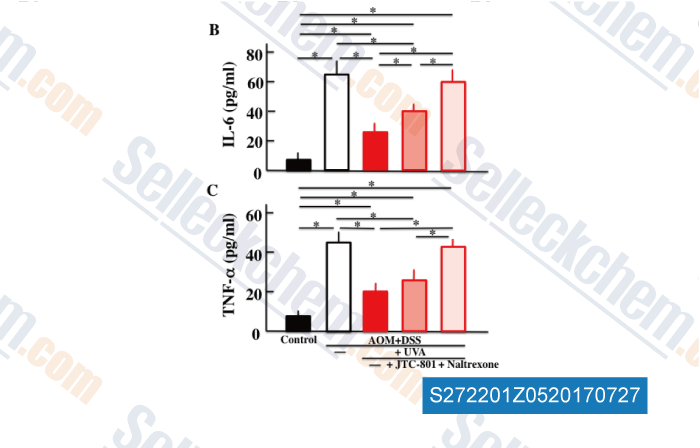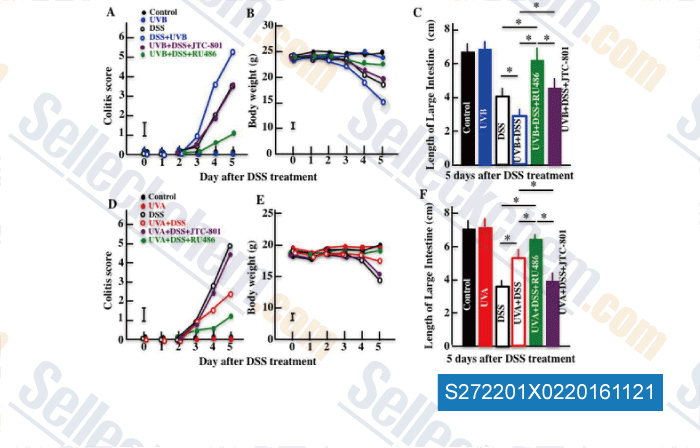|
Toll Free: (877) 796-6397 -- USA and Canada only -- |
Fax: +1-832-582-8590 Orders: +1-832-582-8158 |
Tech Support: +1-832-582-8158 Ext:3 Please provide your Order Number in the email. |
Technical Data
| Formula | C26H25N3O2.HCl |
||||||
| Molecular Weight | 447.96 | CAS No. | 244218-51-7 | ||||
| Solubility (25°C)* | In vitro | DMSO | 90 mg/mL (200.91 mM) | ||||
| Ethanol | 31 mg/mL (69.2 mM) | ||||||
| Water | Insoluble | ||||||
| In vivo (Add solvents to the product individually and in order) |
|
||||||
|
* <1 mg/ml means slightly soluble or insoluble. * Please note that Selleck tests the solubility of all compounds in-house, and the actual solubility may differ slightly from published values. This is normal and is due to slight batch-to-batch variations. * Room temperature shipping (Stability testing shows this product can be shipped without any cooling measures.) |
|||||||
Preparing Stock Solutions
Biological Activity
| Description | JTC-801 is a selective opioid receptor-like1 (ORL1) receptor antagonist with IC50 of 94 nM, weakly inhibits receptors δ, κ, and μ. | ||
|---|---|---|---|
| Targets |
|
||
| In vitro | JTC-801 displays about 12.5-, 129-, and 1055-fold selectivity for ORL1 receptor (Ki = 8.2 nM) over μ-, κ-, and δ-opioid receptors, respectively. JTC-801 does not inhibit forskolin-stimulated cyclic AMP accumulation in human ORL1 receptor-expressing HeLa cells, but it prevents nociceptin-induced inhibition of cyclic AMP accumulation, indicating that JTC-801 possesses full antagonistic activity. [2] In rat cerebrocortical membrane, JTC-801 inhibits ORL1 receptor with IC50 of 472 nM and μ-receptor with IC50 of 1831 nM. JTC-801 completely antagonizes the suppression of nociceptin on forskolin-induced accumulation of cyclic AMP with IC50 of 2.58 μM in HeLa cells expressing ORL1 receptor. [1] | ||
| In vivo | Oral administration of JTC-801 (0.3-3 mg/kg) antagonizes nociceptin-induced allodynia in mice, and shows analgesic effect in a hot plate test using mice and in a formalin test using rats. [2] In mouse hot-plate test, JTC-801 prolongs escape response latency (ERL) or exposed heat stimulus with minimum effective doses (MED) of 0.01 mg/kg by i.v. or 1 mg/kg by p.o. In the rat formalin test, JTC-801 reduces both the first and second phases of the nociceptive response with MED of 0.01 mg/kg71 by i.v. or 1 mg/kg by p.o. [1] JTC-801 dose-dependently normalizes paw withdrawal latency (PWL). Although JTC-801 does not inhibit a chronic constriction injury (CCI)-induced decrease in bone mineral content (BMC) and bone mineral density (BMD), it inhibits an increase in the number of osteoclasts. [3] Tactile allodynia induced by L5/L6 spinal nerve ligation is reversed by both systemic (3-30 mg/kg) and spinal (22.5 and 45 pg) JTC-801 in a dose-dependent manner. Furthermore, systemic JTC-801 reduces Fos-like immunoreactivity in the dorsal horn of the spinal cord (laminae I/II). [4] JTC-801 produces dose-dependent mechanical and cold anti-allodynic effects with ED50 of 0.83 mg/kg and 1.02 mg/kg, respectively. [6] |
Protocol (from reference)
| Animal Study: |
|
|---|
References
Customer Product Validation

-
, , Antimicrob Agents Chemother, 2016, 60(6):3813-6.

-
Data from [Data independently produced by , , Photodermatol Photoimmunol Photomed, 2017, 33(2):84-91]

-
Data from [Data independently produced by , , Photochem Photobiol, 2016, 92(5):728-34.]
Selleck's JTC-801 has been cited by 8 publications
| ACSS2-mediated NF-κB activation promotes alkaliptosis in human pancreatic cancer cells [ Sci Rep, 2023, 13(1):1483] | PubMed: 36707625 |
| A compendium of kinetic modulatory profiles identifies ferroptosis regulators [ Nat Chem Biol, 2021, 10.1038/s41589-021-00751-4] | PubMed: 33686292 |
| Targeting NF-κB-dependent alkaliptosis for the treatment of venetoclax-resistant acute myeloid leukemia cells [ Biochem Biophys Res Commun, 2021, 562:55-61] | PubMed: 34034094 |
| Ultraviolet A eye irradiation ameliorates colon carcinoma induced by azoxymethane and dextran sodium sulfate through β‐endorphin and methionine‐enkephalin [Hiramoto K, et al. Photodermatol Photoimmunol Photomed, 2017, 33(2):84-91] | PubMed: 28039905 |
| The amelioration effect of tranexamic acid in wrinkles induced by skin dryness [Hiramoto K, et al. Biomedicine & Pharmacotherapy, 2016, 80:16-22] | |
| The amelioration effect of tranexamic acid in wrinkles induced by skin dryness [ Biomed Pharmacother, 2016, 80:16-22] | PubMed: 27133035 |
| The amelioration effect of tranexamic acid in wrinkles induced by skin dryness. [ Biomed Pharmacother, 2016, 80:16-22] | PubMed: 27133035 |
| The Effects of Ultraviolet Eye Irradiation on Dextran Sodium Sulfate-Induced Ulcerative Colitis in Mice [Hiramoto K, et al. Photochem Photobiol, 2016, 92(5):728-34] | PubMed: 27428018 |
RETURN POLICY
Selleck Chemical’s Unconditional Return Policy ensures a smooth online shopping experience for our customers. If you are in any way unsatisfied with your purchase, you may return any item(s) within 7 days of receiving it. In the event of product quality issues, either protocol related or product related problems, you may return any item(s) within 365 days from the original purchase date. Please follow the instructions below when returning products.
SHIPPING AND STORAGE
Selleck products are transported at room temperature. If you receive the product at room temperature, please rest assured, the Selleck Quality Inspection Department has conducted experiments to verify that the normal temperature placement of one month will not affect the biological activity of powder products. After collecting, please store the product according to the requirements described in the datasheet. Most Selleck products are stable under the recommended conditions.
NOT FOR HUMAN, VETERINARY DIAGNOSTIC OR THERAPEUTIC USE.
